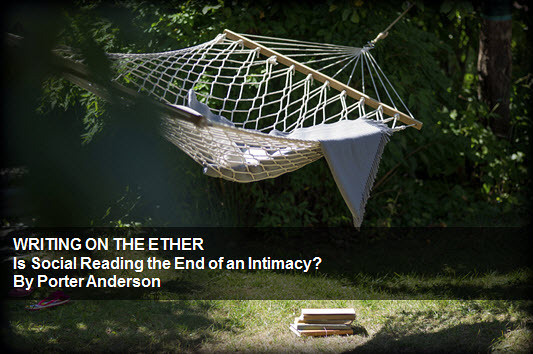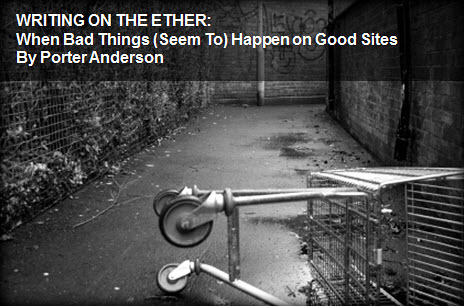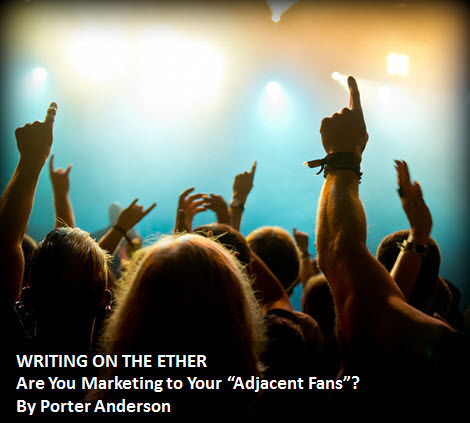Jane Friedman's Blog: Jane Friedman, page 172
September 4, 2013
A Valuable Lesson About Revision

photo by Rami / Flickr
These last few months, I have been busily working on material for Scratch, a digital magazine I’m launching this fall with Manjula Martin. (I’ll be ready to tell you more in a couple weeks.)
I have spent more time rewriting my work than writing it, which I expected. Or, I believe the old adage is true: “Writing is rewriting.”
In his essay for Glimmer Train, Phil Tate discusses a valuable lesson of rewriting, or revision:
Willful expansion adds stuff. Some of it is good, some of it is not, and forcing myself to cut deeply—not only when it was good enough but when it was good—made a stronger, more tightly focused story.
Read Tate’s full essay here. (And stay tuned to Scratch here.)
Other pieces from Glimmer Train this month:
On Being Not a Writer by Xhenet Aliu
A Picture and a Thousand Words by Carrie Brown
The post A Valuable Lesson About Revision appeared first on Jane Friedman and was written by Jane Friedman.
September 3, 2013
Is Crowdfunding Right for You? 5 Questions

Photo by boinink / Flickr
Today’s guest post is by Justine Schofield, the communications coordinator for Pubslush, a crowdfunding publishing platform.
You’ve probably heard of crowdfunding by now. Crowdfunding is a means for artists, entrepreneurs, and businesses to raise funds and mitigate the financial risk of their creative projects or business ventures. You generate financial backing from people who believe in your project: your family, friends, community, and audience. (A few noteworthy services for crowdfunding: Kickstarter, Indiegogo, and Pubslush, where I work.)
Crowdfunding can be a feasible option for writers looking to self-publish. Not only can a successful campaign lessen your financial burden, but it can also help you gauge the audience for their book. However, before diving head first into a crowdfunding campaign, you should be able to answer the following questions.
1. Do you have a pre-existing network that will support your book?
What many people don’t realize is that unless you’re Zach Braff or Amanda Palmer, who both conducted enormously successful campaigns, most of your supporters will be from your personal and professional network. Of course, every crowdfunding campaign hopes to attract people from outside of their network who simply love the idea behind the project, but this can’t be counted on. If you don’t have a strong network or author platform prior to the start of your campaign, it will be difficult to be successful.
2. Are you willing to ask people for financial backing?
There’s absolutely no shame in crowdfunding. You are seeking financial backing in exchange for a reward and the promise of producing a product the supporter believes in. With this model, consumers are the gatekeepers of what products are produced, giving them a new kind of purchase power. However, many people simply don’t feel comfortable asking other people for money, which is exactly what you have to do in crowdfunding: ask.
3. Does your book have a niche audience?
Many books have a niche. For example, Janna Leyde wrote a memoir, He Never Liked Cake, about dealing with her father’s traumatic brain injury (TBI) after he was involved in a serious car accident when she was 14. She was able to reach out to TBI groups and associations for support and successfully raised over $15,000 to publish her book. If your book has a niche audience, which many do, conduct research about what organizations and influential people you can reach out to for support and media coverage. Specifically targeting your out-of-network outreach will lessen the scope of your marketing and yield more positive results.
4. Do you have a marketing plan?
Devising a marketing plan, before launching a campaign, is essential for success. Many people who attempt to crowdfund think they can wing it, or do very little advance planning. Sounds nice, but this is unrealistic and will ultimately be detrimental to the success of a campaign. Campaigns are time sensitive (most last 30-60 days), so it’s important to develop a week-by-week marketing plan and create weekly outreach goals prior to the launch of your campaign. Having a target outreach audience for each week (i.e. friends and family, professional network, audience, niche organizations and bloggers, etc.) will help guide your campaign and keep you from getting overwhelmed. Also, try and tell at least one new person about your campaign every day to keep the momentum up.
5. Are you willing to put in the time and effort?
Even if you’ve developed a comprehensive marketing plan there’s still the challenge of carrying it out. Crowdfunding is not easy. It’s a time commitment that requires a lot of hard work and dedication. You should reach out to people on a personal level (yes, sorry, this means no mass e-mails), and toward the end of your campaign you should follow up with the people who haven’t yet responded to you.
Yes, you will be tired of talking about your campaign by its completion, but continuous commitment and marketing is necessary. If you’re a writer hoping to crowdfund, but can’t answer “yes” to most or all of these questions, then maybe now isn’t the right time for you to begin a campaign.
The post Is Crowdfunding Right for You? 5 Questions appeared first on Jane Friedman and was written by Justine Schofield.
August 30, 2013
4 Big Pitfalls in Story Openings
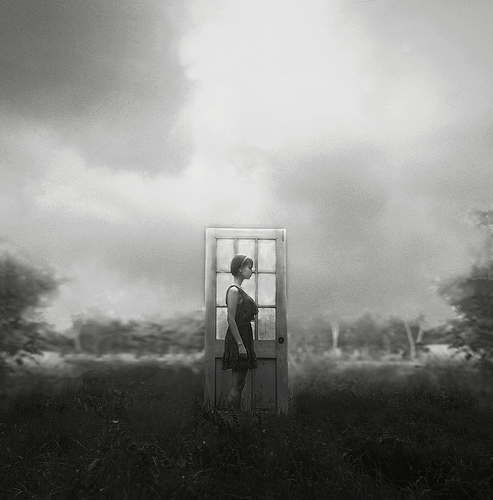
Photo by Emily White / Flickr
Today’s guest post is excerpted from Structuring Your Novel by novelist K.M. Weiland (@kmweiland).
Beginnings are difficult when you consider their weight in the overall story. They must accomplish all of the following:
Plant an irresistible hook.
Give readers a reason to care about what happens to the characters.
Introduce overall tone (satiric, dramatic, etc.).
Introduce setting (time and place), conflict, and theme.
The beginning of a story is rather like a résumé. You flaunt your talents and skills and hope readers find what they’re looking for. Otherwise, you’re never going to make it off the bookstore shelf.
Here are four of the biggest pitfalls in story openings.
1. False Suspense
As your story unfolds, you want readers asking concrete questions. Who stole the Statue of Liberty? How is Westley going to escape the Pit of Despair? Why did Cinderella order glass slippers a size too large? You don’t want them asking the dreaded four-word question: What’s going on here? Or, worse: Huh?
Be wary of creating false suspense—the kind of suspense that has readers floundering to understand the basics of your scene. False suspense may have readers asking questions such as:
What is this character’s name? Award-winning author Linda Yezak explains, “[N]ameless, faceless characters don’t usually draw readers into the story. In other words, get your readers to bond with your characters early … [by letting] the reader know who they are.”
How old is this person? You don’t have to spell out every character’s age. But if you’re writing about an 80-year-old, don’t give readers a chance to imagine he’s only 17 (or vice versa).
Who is this person? Readers need to know something about your character from the start. This could be his occupation, a prominent personality trait, or a defining action.
Where is this scene taking place? Don’t leave your characters exploring a white room. Readers need to know if the scene is taking place in a café, a forest, a bedroom, or an airplane.
Who is this character interacting with? If other characters are present in the scene, give readers a little help by naming them. “He” or “she” just doesn’t give readers much to work with the first time they’re introduced to a character.
2. Prologue
Writers have an ongoing love affair with prologues. It is often intended to fill readers in on important need-to-know info, so they’ll understand what’s going on when they dive into the “real” beginning of the story.
However, the prologue is a prime example of writers wanting to hold their readers’ hands. Because we’re convinced readers won’t be able to figure out the backstory without a little help, we proceed to spell it out in the greatest possible detail.
At first glance, that’s not necessarily a bad thing. Lack of information can undermine the entire arc of the story and leave readers uncertain and dissatisfied. But are prologues the best way to supply that necessary information?
Chief among the prologue’s inherent flaws is that it forces readers to begin a story twice. Any emotion they may have invested in your story will be threatened by the switch that takes place when they turn the page and find themselves staring at “Chapter One.”
I can hear writers everywhere saying, “But the information in my prologue is vital! My story simply won’t work without a prologue!” Take a closer look at your first chapter. Generally, you’ll find that a strong first chapter (a must with or without a prologue) will provide a better opening for your story than the prologue. Too often, prologues are little more than information dumps. That is, after all, their purpose. And therein lies the problem. Backstory is much more effective once readers have a reason to care about your characters.
Does all this mean prologues are always a bad idea? No. But effective prologues aren’t for the faint of heart or the unskilled. An effective prologue must accomplish two tasks:
It must hook readers.
It must do so without distancing readers from the story they came to read.
Some of the best prologues are short (containing little other than the hook itself) and very sparse on character or story development. These prologues don’t even attempt in-depth character or plot introductions. They exist merely to impart some important information—be it an event that occurs previous to the story, an event that occurs after the story, an antagonist perspective, etc.
Robert Ludlum’s The Bourne Identity opens with two newspaper articles conveying information about the story’s antagonist and effectively setting the scene for the hero’s entrance. The prologue is short, smart, and doesn’t require readers to invest their emotions only to reinvest them at the beginning of Chapter 1.
Consider two rules to govern your use of the prologue:
Unless absolutely necessary, skip the prologue.
If a prologue is unavoidable, make it short, open it with a solid hook, and avoid as much drawn-out narration and info dumping as possible.
3. Dream Sequence
Agents and editors dislike stories that begin with dream sequences—mostly because dream beginnings tend to suffer from the same problems as prologues. They almost always fail to present a strong hook, character, setting, conflict, or frame. There are exceptions to this rule, but your wisest move is generally to cut the dream and find a stronger opening.
Before surrendering to the temptation to open your story with a dream, stop and ask yourself the following questions:
Is the dream absolutely necessary to the story?
Is it clear?
Does it contain conflict or tension?
Does it advance character growth?
If the answer to any of these is no, you’d be wise to trim the dream to a sentence or two—or delete it entirely.
4. Too Much Backstory
Sooner or later, most authors feel the constraints of opening a story in medias res. How can readers fully comprehend events unless we’ve first given them an understanding of the important backstory that preceded the opening? But if info dumps, prologues, flashbacks, and dream sequences aren’t the answer, what is? How can you spare readers from confusion while still avoiding too much backstory in your opening chapters?
Backstory is at its most powerful when we don’t tell it—or rather when we don’t show it. The strength of backstory is its looming shadow. Readers know it’s there, they see the effect it’s having upon the characters, but they don’t always need to know the nitty-gritty details.
Consider the two movie adaptations of The Scarlet Pimpernel—the one made in 1934 with Leslie Howard, and the one made in 1982 with Anthony Andrews. The films are very similar in their telling of this classic story, with the exception that the much longer 1982 version spends almost a full hour detailing Sir Percival Blakeney’s courtship, marriage, and subsequent discovery of his wife’s apparent treachery against a doomed family of French nobles. In the 1934 version, these events comprise the backstory and are related only in bits and pieces throughout the body of the film. Because of this very thing, the earlier film is by far the stronger bit of storytelling.
The important lesson to be gleaned here is twofold:
Backstory must matter. If it doesn’t matter in a way that moves the plot forward, it doesn’t deserve to be told.
It must be artfully placed within the story so readers understand its importance to the plot and can’t wait to discover the secrets in your characters’ pasts.
The ballast provided by backstory gives our stories greater depth and meaning and opens up the potential for interpretation. If we turn too much of our backstory into the story, or illustrate too much of it via detailed flashbacks (either at the beginning of our stories or in subsequent chapters), we rob our readers of the sense of weight given by 9/10ths of the iceberg floating under the water of our stories.
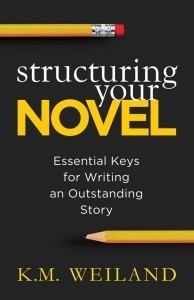 Note from Jane: If you found this post helpful, I encourage you to check out K.M. Weiland’s Structuring Your Novel. You can download the first chapter at Amazon.
Note from Jane: If you found this post helpful, I encourage you to check out K.M. Weiland’s Structuring Your Novel. You can download the first chapter at Amazon.
The post 4 Big Pitfalls in Story Openings appeared first on Jane Friedman and was written by K.M. Weiland.
August 29, 2013
WRITING ON THE ETHER: Is Social Reading the End of an Intimacy?
Table of Contents
I Want To Be Alone
The “Annotated” Solitude
Social Reading: The OFF Button
I Want To Be Alone
Recently, I waded into the question of how we talk about the relative isolation (or not) in which authors work. In response to Are You Lonesome Tonight? The Dreaded Solitude of Writing, the Writer Unboxed community got into an articulate comments-discussion of the topic, lots of angles and points of view coming into the mix.
Today, I’d like to ask your thoughts about that person who sits on “the other side of the book.” If an author works largely alone on creating the work itself, how do we see the reader: also alone?
“Attention is the rarest and purest form of generosity.” —Simone Weil | For more on this: http://t.co/9XwDfCHbAF
— Jane Friedman (@JaneFriedman) August 24, 2013
Start with that tweet from Virginia Quarterly Review’s Jane Friedman, tireless host of the Ether.

Jonathan Safran Foer
It takes you to a New York Times opinion piece, How Not To Be Alone by author Jonathan Safran Foer. No Luddite breast-beating here. Foer seems thoroughly and consciously invested in the grid, like so many of us, writing:
My daily use of technological communication has been shaping me into someone more likely to forget others. The flow of water carves rock, a little bit at a time. And our personhood is carved, too, by the flow of our habits…We often use technology to save time, but increasingly, it either takes the saved time along with it, or makes the saved time less present, intimate and rich. I worry that the closer the world gets to our fingertips, the further it gets from our hearts.

Emily St. John Mandel
Hang on to that and look now at a new essay with suggested reading (news you can use, baby) from author Emily St. John Mandel at The Millions. On The Pleasures and Solitudes of Quiet Books is led by Mandel’s quotation from author Rebecca Solnit’s memoir, The Faraway Nearby, emphasis mine:
This is the strange life of books that you enter alone as a writer, mapping an unknown territory that arises as you travel. If you succeed in the voyage, others enter after, one at a time, also alone, but in communion with your imagination, traversing your route. Books are solitudes in which we meet.
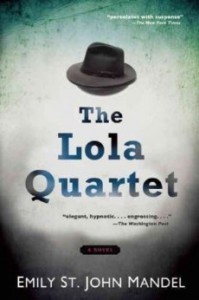 Mandel, writing about the challenge of finding seclusion in urban life, turns to the related concept of the quiet book.
Mandel, writing about the challenge of finding seclusion in urban life, turns to the related concept of the quiet book.
This is the kind of term we don’t handle well in publishing, like literary and (helmets on:) amateur. The mere mention of a quiet book can make weird defenses go up quickly, somehow, as if someone has just said that “louder,” brassier efforts aren’t valuable. For the record, Mandel clarifies, “I have an immense love for loud books.”
But special intellectual seclusion can be found in quiet books, something worth considering Mandel:
Any definition of what constitutes a quiet book will naturally be subjective, but I think the important point here is that quiet isn’t the same thing as inert. I’m not talking about the tediously self-conscious novels written by authors who use “literary fiction” as a sort of alibi, as in “my book doesn’t have a plot, because it’s literary fiction.” I rarely get more than fifty pages into these books before they join the books-that-need-to-get-out-of-my-apartment-immediately pile by the front door. Nor is quiet necessarily the same thing as minimalist. Raymond Chandler’s prose is minimalistic, but his stories aren’t quiet.
The books I think of as being quiet, the ones I’ve been enjoying lately, have a distilled quality about them, an unshowy thoughtfulness and a sense of grace, of having been boiled down to the bare essentials.
@Porter_Anderson @EmilyMandel beautiful, elaborate, clockwork solitudes.
— Mathew Lebowitz (@MathewLebowitz) August 27, 2013
Mandel offers six books of that quiet variety and a quick comment on each.

Rebecca Solnit
Author and activist Solnit, meanwhile, is on Facebook in a diary entry with an extended commentary on the fragmentation of attention. Her larger point involves her views of the management and monitoring of our time and privacy by commercial and political entities. 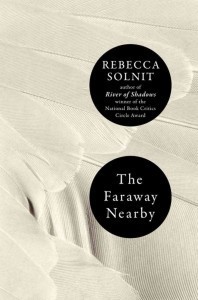 Her descriptions of what seems to be happening to the most intimate element of our time strike home easily:
Her descriptions of what seems to be happening to the most intimate element of our time strike home easily:
My time does not come in large, focused blocks, but in fragments and shards. The fault is my own, arguably, but it’s yours too – it’s the fault of everyone I know who rarely finds herself or himself with uninterrupted hours. We’re shattered. We’re breaking up…Space for free thought is routinely regarded as a void, and filled up with sounds and distractions.
And this is where I become concerned. How much of the author-reader intimacy are we talking about trading away in social reading? And is it worth it? Back to Table of Contents
This is insane. A Times Square ad for Audible that features SHIFT. It’s running right now! http://t.co/SdYe2e7Q5Z — Hugh Howey (@hughhowey) August 26, 2013
The “Annotated” Solitude

Brian O’Leary
Here is our friend and colleague Brian O’Leary—co-editor with Hugh McGuire of Book: A Futurist’s Manifesto—writing in A Snapshot in Time: For the book, new tools and new forms about interactive reading of periodicals and what its implications could be for books.
Earlier this month Atlantic Media announced that Quartz, an online publication it launched in 2012, would start accepting comments at the level of a paragraph. The first iteration of the service is sponsored (!) by CitiGroup…Quartz senior editor Zach Seward describes the comments as “annotations.” …Now, we have a revenue-producing version of the idea, applied to online comments. Among blogs that receive a decent volume of comments…user-generated content dwarfs the original text. Imagine a book that could claim the same.
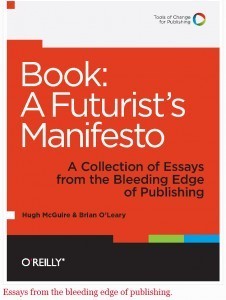 What O’Leary wonders, rightly, is how the very idea of such social reading affects what’s written in the first place; do we still get the same literature?
What O’Leary wonders, rightly, is how the very idea of such social reading affects what’s written in the first place; do we still get the same literature?
This new approach bakes social into the creation of a text, and it makes me wonder if anyone who had developed a text in such an environment would ever render it mute. In a world of social reading, print becomes a snapshot in time.

Damien Walter
That article by O’Leary followed by a few days an article from Damien Walter in the the Guardian, Who owns the networked future of reading? Walter writes as an enthusiast of shared marginalia, and he’s an articulate spokesman.
Readmill aims to fulfil the potential of networked reading. Readers can underline and comment on a text to their heart’s content, then open up those comments for discussion among a growing community of passionate readers.
 I wish the folks at Readmill well. Here’s their nice-looking site. They’re a respected startup in our community and I like their talk of reading “peacefully” in a clean-text environment.
I wish the folks at Readmill well. Here’s their nice-looking site. They’re a respected startup in our community and I like their talk of reading “peacefully” in a clean-text environment.
This bit of video shows you a new review and highlights functionality introduced into Readmill’s iOS app:
Nothing our colleague Henrik Berggren and his team are doing at the Berlin-based Readmill, in fact, makes me unhappy except the fact that Readmill doesn’t seem to be offered for Android, which I prefer. And if you’re an author, check this page at Readmill’s site on which you can look into becoming “a Readmill author” with the app’s functionality made available to your work. The Readmill copy:
Readmill for authors allows you to interact with your readers in a whole new way — right in the margins of your book. See what they are highlighting and sharing, start discussions, and get valuable feedback.

Authors considering going to Frankfurt Book Fair: See Hannah Johnson’s straight-shooting Authors Guide at Publishing Perspectives.
Walter in the Guardian lays out what this approach may enable for writers. He’s referring here, by the way, to a time he found a copy of Thomas Harris’ The Silence of the Lambs left on a train with high-caliber margin notes in it, a feminist critique of the work. He writes:
Readmill allows authors to claim ownership of their books, and interact with readers in the margins of the text. So not only could I and my anonymous commentator debate the feminist critique of The Silence of the Lambs but, should he feel so inspired, Thomas Harris himself could respond, in a conversation directly related to the text itself.

Baldur Bjarnason
Baldur Bjarnason has a comparative look, Readmill versus Kindle—Readmill is worth the hassle, in case you’re interested in comparing the iOS apps of the two. Per O’Leary’s good article, a couple more social reading outfits for you to look at if you’re interested. To our purposes of the social features here, he writes:
Everything regarding highlights, notes, online sharing (twitter, facebook, wordpress), and discussions is top-notch.
 One is SocialBook / Open Utopia, developed by electronic publishing pioneer Bob Stein and his Institute for the Future of the Book. You can read a note from Stein, SocialBook in Action, from earlier this month on how progress is coming with the beta program and get a look at what they’re working on.
One is SocialBook / Open Utopia, developed by electronic publishing pioneer Bob Stein and his Institute for the Future of the Book. You can read a note from Stein, SocialBook in Action, from earlier this month on how progress is coming with the beta program and get a look at what they’re working on.

Bob Stein
An interesting line from Stein’s evolving understanding (over two years) of what they’re doing:
SocialBook it seems is a terrific example of an emerging class of applications that might be called “[collaborative] thinking processors” as opposed to reading environments or word processors. SocialBook’s structure enables multiple perspectives to be brought to bear on a problem. It’s an exciting real-world proof of Alan Kay’s dictum that “point of view is worth 80 IQ points”
 Another key startup in the field O’Leary has mentioned is ReadSocial, and you’ll find there’s some delightful tango music behind the video on that page to explain what ReadSocial calls “virtual reading groups.” In the video animation, folks read the same material on different devices and then interact in a networked group to enjoy such amenities as:
Another key startup in the field O’Leary has mentioned is ReadSocial, and you’ll find there’s some delightful tango music behind the video on that page to explain what ReadSocial calls “virtual reading groups.” In the video animation, folks read the same material on different devices and then interact in a networked group to enjoy such amenities as:
Instant conversations on any paragraph…social features & groups you don’t need to build…additional comments imported from other systems…flexible design (use our layout or yours)…
Travis Alber’s ideas and the slick presentation make this paid service (free trial, of course) pretty tempting. In fact, look at all the fun I’m having. Didn’t I start this thing sounding pretty worried about what social reading might do to us?
What’s different about reading on the phone? Attention span, how & where we read, depth of processing & interrupted flow #ixdamf — IxDA London Local (@IxDALondon) August 28, 2013
I’m not criticizing the work of these startup efforts in social reading. I’m as intrigued as the next person. I’m probably less inclined than some to welcome everybody’s marginalia in my reading. But in the aggregate, I love what digital capabilities are bringing to our potential of networked books, which is the focus each year of the Books in Browsers conference Peter Brantley produces in San Francisco.
But i believe that deep down we’re all nerds. Just have different ways of showing it. #theconf @oredev
— Jakob Wolman (@jakobwolman) August 22, 2013
I just wonder what full-on social integration may do to reading. And I’m good enough at cognitive dissonance—and betting you are, too—to believe it’s worth our asking what it might do to our reading while being excited by the possibilities it may bring us.

From VQR: More on poet Cherryl T. Cooley
Social Reading: The OFF Button
It was the best of times, it was the worst of times, it was the age of wisdom, it was the age of foolishness, it was the epoch of belief, it was the epoch of…
Wait a minute, I’m sorry. I was distracted by a comment from somebody on that line there. Dickens said it was an epoch of what?
@bookriot Isn’t that cool? We want more social reading!
— HuffPost Books (@HuffPostBooks) July 23, 2013
You have, I’m sure, heard that we’re now deeply into the marketing mavens’ land of many screens. This means that we watch television with other screens on us and around us. That’s so we can tweet along with our friends while seeing a show. Post wisecracks about the costumes on Facebook for our adoring fans (they love our wittiness, don’t they?). Stab, I mean pin, things onto our boards that we find diverting, maybe screengrabs from the very shows we’re watching, and boy, am I glad this column is not about the rights issues that might involve. Have you tried multi-screen TV watching?
Well, that was all very interesting. #unrelated — Chris Guillebeau (@chrisguillebeau) August 27, 2013
What I’ve found is that you don’t get nearly as much from something you’re “watching” when you’re also trying to “be social” about it. Sociologists now tell us that multitasking is largely a myth. We’re actually switching from one task to another, not performing two or more things simultaneously. And, per a study I covered at CNN from University of Michigan researcher David Meyer, Ph.D., we may lose 20 seconds or more each time we change from one very simple task to the next. Here’s Walter from his Guardian article again:
To understand what a fully realised network reading experience might mean, imagine reading a book published in 2013 in the year 2063. In the 50 years between now and then, dozens of critical texts, hundreds of articles, thousands of reviews and hundreds of thousands of comments will have been made on the text. In a fully networked reading experience, all of those will be available to the reader of the book from within the text.
Wow. What a mess. No, that’s not right. I mean, what a gold mine. Right? Well, we have to hope right, yes.
After solving all other problems, foreign and domestic? RT @PublishersWkly: Obama Responds to Bookseller Criticism http://t.co/qbGiKoK4Oa
— Don Linn (@DonLinn) August 28, 2013
I’m imagining pop-up notes nudging me with other readers’ bright ideas; reviews rolling all over the place; and marginalia marching around the glowy screen of my preferred tablet reading device. More from Walter:
Authors are able to shape the discussion on their books, moderating comments in a system similar to a blogpost. They can maintain a relationship with all the readers who have enjoyed their books, be that a few dozen or a few hundred million.
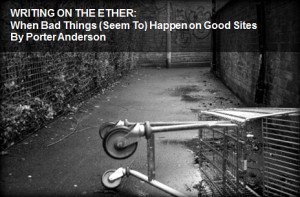 Shape the discussion? For a look at how pleasant a task handling all that relationship work might be, see last week’s Writing on the Ether: When Bad Things (Seem To) Happen on Good Sites, the Attacks section. I mean the Comments section. (Check how many times the word “attack” appears in the comments. ) Look, will I scare you to death if I write the phrase “non-sexual intimacy” here? Smelling salts will be provided at the door. We don’t have a lot of this stuff left. Not smelling salts, non-sexual intimacy.
Shape the discussion? For a look at how pleasant a task handling all that relationship work might be, see last week’s Writing on the Ether: When Bad Things (Seem To) Happen on Good Sites, the Attacks section. I mean the Comments section. (Check how many times the word “attack” appears in the comments. ) Look, will I scare you to death if I write the phrase “non-sexual intimacy” here? Smelling salts will be provided at the door. We don’t have a lot of this stuff left. Not smelling salts, non-sexual intimacy.
I have been to parts of Tasmania that were easier to get to than the FDR Drive was this evening. — Ginger Clark (@Ginger_Clark) August 29, 2013
Now that we’re watching TV with three and four screens at once (and missing everything but the commercials); now that music is a mere soundtrack for everything else we’re doing; now that even in a cinema everybody’s tweeting their brains out to each other during the film (no one who reads the Ether would do this, of course). When do we still get together, mind-to-mind and share the dark, “quiet book” secrets of one (author’s) consciousness delivering its wonders directly into another (the reader’s)? When we read. Alone.
Meet the First Mashable Reads Author, @adellewaldman! http://t.co/YitFGavitQ #mashreads — Mashable (@mashable) August 19, 2013
In all fairness, let’s narrow this issue mainly to fiction, because in much nonfiction, there may be many reasons that social-reading tool sets make good sense.

John le Carré
What about “immersive” fiction? (Merriam-Webster swears “immersive” isn’t really a word, just to declare my transgression there.)
This week, I’ve been reading John le Carré’s A Delicate Truth (on the recommendation of our colleague Don Linn, by the way).
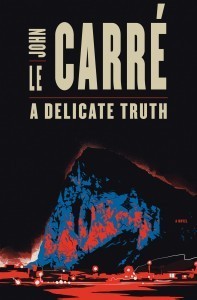 Le Carré is at the height of his powers, the book is one of the most assured demonstrations of its genre, and in a very good season for that line of fiction, too.
Le Carré is at the height of his powers, the book is one of the most assured demonstrations of its genre, and in a very good season for that line of fiction, too.
I want le Carré’s masterful voice boring its vision into my construct unimpeded, without anything to distract me. I read him in hour-long stretches, no interruptions allowed.
Do I want to get social with that book?
A part of A Delicate Truth is set on Gibraltar, as that unfortunately indelicate cover suggests. So I’m supposed to be trying to grok le Carré’s text and some jackass’ margin notes about his vacation to the Mediterranean go bouncing by as I swipe from one page to the next?
A literary thriller is a novel you don’t realise is a thriller; a commercial thriller is a thriller you don’t realise is a novel.
— Jonny Geller (@JonnyGeller) August 28, 2013
The solitude of the reader is something we sully at our peril.
And our busy developers gussying up social reading platforms need provide us with an escape. An OFF button. I will use it. Indeed, if I can’t turn off these fine features when I want to, I’ll be as anti-social in reading as I am (some tell me) in life.
Contemplating a new type of reading app after tonight’s #ixdaMF, with a toggle switch between social & distraction-free reading.
— alastair horne (@pressfuturist) August 28, 2013
The lone reader is social. Solnit and Mandel already told us this:
Books are solitudes in which we meet.
As a reader, I want to meet my author in those solitudes. Just us.
And the masses? Don’t call me, I’ll call you.
And I’m calling you now: Tell me what you think. Do you ever wonder why we’re trying to make so much of life social? Do you wonder if reading needs to be social? Or is this just a “because we can” trend? Chime right in, just give a rest to the word “attack” this week, if you don’t mind. 
.@laurahazardowen Having just gotten a new Nexus 7, only Apple can still justify selling a tablet for > $299. Go home, Kobo. You’re drunk!
— Guy L. Gonzalez (@glecharles) August 28, 2013
Main image: iStockphoto – lainea
The post WRITING ON THE ETHER: Is Social Reading the End of an Intimacy? appeared first on Jane Friedman and was written by Porter Anderson.
August 28, 2013
Does Social Media Really Sell Books?
In brief, yes and no.
Over at Writer Unboxed, I’ve written a post on social media marketing. It begins:
Most new authors, upon securing a book contract or planning a book launch, are advised they need to establish a Twitter account, a Facebook page, or [list social media channel here]. Why? To market their book, of course.
This presents an immediate dilemma: If the author is not already active on these channels, of her own interest and volition, she now has the mindset of using these tools to “market”—and the new author may have no idea what that means beyond telling people to like their page or follow them.
Go read the full post (with a wonderful discussion in the comments), A Key Marketing Principle That Authors Must Learn (or Not Forget).
And for those paying attention, I am once again a regular Writer Unboxed columnist. It’s good to be back, and my thanks to Therese and the WU family for so warmly welcoming my return.
The post Does Social Media Really Sell Books? appeared first on Jane Friedman and was written by Jane Friedman.
August 22, 2013
WRITING ON THE ETHER: When Bad Things (Seem To) Happen on Good Sites
Table of Contents
Goodreads: “We take all these comments very seriously”
“I despise all of this drama”
It’s Just Books
Goodreads: “We take all these comments very seriously”
You don’t necessarily think the world of bookworms would be full of bullies.
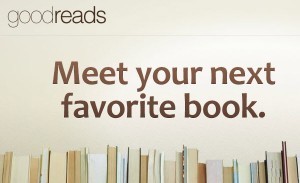 Ether readers’ private notes to me about recent allegations of reader-on-author bullying at Goodreads have been intelligently restrained—concerned, not accusatory; baffled, not indignant. Communicating in direct message on Twitter and in email with me, readers have asked about this issue in terms of searching, thoughtful worry.
Ether readers’ private notes to me about recent allegations of reader-on-author bullying at Goodreads have been intelligently restrained—concerned, not accusatory; baffled, not indignant. Communicating in direct message on Twitter and in email with me, readers have asked about this issue in terms of searching, thoughtful worry.
So I’m especially glad to have new reassurance from Otis Chandler‘s managerial team at the Goodreads offices in San Francisco to offer you, and on a very tight deadline. I’m placing this statement first, hoping you’ll bear it in mind as we look at some details of recent remarks.
From Goodreads, then:
We take all these comments very seriously and would like to make it clear that threatening violence against other Goodreads members is not tolerated on the site, and any such content will be removed promptly when brought to our attention.
If any of your readers have any concerns, please encourage them to bring it to our attention at support@goodreads.com and we’ll investigate and take the appropriate action.
As a point of process, I might add that if you need to register a concern at that email address, put something direct in the subject line (along the lines of “Possible Abuse,” etc.), so the support staff can quickly identify your correspondence as sensitive.
 Now. A single ground rule as we look at what’s afoot: No one is objective (as journalists learn very quickly about themselves), but we can all try to be fair. And sometimes this means the best we can do is be very clear in acknowledging what we don’t actually know.
Now. A single ground rule as we look at what’s afoot: No one is objective (as journalists learn very quickly about themselves), but we can all try to be fair. And sometimes this means the best we can do is be very clear in acknowledging what we don’t actually know.
Hearsay can be intensely damaging. Confusion can be as big an enemy as mendacity. Having to say, “I just don’t know what happened, I wasn’t there,” can be less gratifying than adopting the claims of others as factual.

Mary Elizabeth Williams
The line I started with—”You don’t necessarily think the world of bookworms would be full of bullies”—is the lead on Mary Elizabeth Williams’ writeup at Salon, Did a writer get bullied on Goodreads?
In her piece, Williams summarizes her understanding of the assertions of a writer named Lauren Howard.
On her Tumblr site, Howard identifies herself as being 22 and English. She says she had intended to launch a book titled Learning to Love, and now has decided not to publish because of bad experiences on Goodreads.

Lauren Howard
Briefly, Howard writes of asking (in a forum) a procedural question as a Goodreads newcomer. She wanted to know how she was attracting ratings of her book before it was published.
As it turns out, these are ratings of interest (not of review) that Goodreads members can make, based on a forthcoming book’s description.
Howard writes:
I was then attacked by people for asking that question. People started to rate 1-star to prove “we can rate whatever the hell we want.” My book was added to shelves named ‘author should be sodomized’ and ‘should be raped in prison’ and other violent offensive things, all for asking a simple question as a newcomer to the website.
Williams at Salon adds that “those earlier comments on Goodreads have now been deleted, so it’s impossible to gauge their severity, or how a young, debut author with a self-published book may have viewed them. ”
I’ve got A-Rod Fatigue.
— James Scott Bell (@jamesscottbell) August 20, 2013
What we can see, though, is reaction to Howard’s descriptions of her experience. Here is one, for example, from an Ether reader to me in email:
This little incident was the first time I’ve seen these horrific threats first-hand, but I know it’s an iceberg tip. I hear heartbreaking tales of this kind of abuse on a regular basis, and it seems to be escalating.
And this from another Ether reader, this time on Twitter:
There are packs of people (authors/reviewers alike) that are out of control on the site.

Tina Klinesmith
And here’s a blogger’s response to the matter. In Bullies on Goodreads? What’s next?, author Tina Klinesmith writes:
A smear campaign began simply from [Lauren Howard's] question as several people began giving her book 1-star ratings and adding it to “shelves” that threatened body harm and harassment to the new author. When she contacted Goodreads about the issue, she was informed that this was allowed and fell under the “freedom of speech” umbrella.
For all our praise of community—and despite Goodreads’ foundation on that very concept—what you’re seeing is community members, with all good intentions, handling things that are known only through partially observed and emotionally described assumptions as if they were fully visible to us. As you’ll see in our next section, Lauren Howard already is writing about the situation being “so blown out of proportion.” Back to Table of Contents
Conclusion from @dekaminski read it#theconf pic.twitter.com/mNxYmaNBoS — Brit Stakston (@britstakston) August 21, 2013
“I despise all of this drama”
The climb-down is a peculiarly familiar move in our culture today, and hardly just in publishing. One frequent feature of it is that it’s rarely announced as such by a person performing it. Embarrassment, lingering confusion, pride—these and more quite understandable components might be in play. In a new Tumblr post headlined Hopefully clearing stuff up…, Lauren Howard later has written:
Never did I expect (or plan!) for this to be so blown out of proportion…I cannot stress enough that though some people didn’t, I personally, originally perceived shelves as threats…When you are feeling targeted and victimized and a whole lot paranoid, it’s easy to feel like you’re being threatened.
As you may know, Goodreads members can name their virtual book “shelves.” Some members seem to enjoy naming them with colorful language that might be described as ribald genre designations. Howard:
As a friend of mine pointed out, no one could physically hurt me. I was not afraid of that at any point. I DO NOT condone these articles making it out like I was afraid people were going to turn up at my house and rape me for God’s sake. I was afraid because of the exposure I was getting and the negativity following.
If I had created a shelf at Goodreads called “Shirtless Men Kissing Beautiful Women”—my own overworked line for romance novels of a certain cover trend—might that line be interpreted by someone else as threatening or abusive? Perhaps. Eye of the beholder.
Because the world’s been waiting for a book of Drew Barrymore’s ‘heart shaped photographs…” — Don Linn (@DonLinn) August 22, 2013
And can we doubt that something Howard experienced as really unpleasant occurred? Probably not, and I’m sure we all wish her well. I think it’s reasonable to accept her explanation of being very upset by what she had perceived as hostility. I’ve seen enough messages relative to the event to know that she did, at the very least, run into a snarky, impatient tone in some instances and I fear there’s a good likelihood that she was treated to worse. Embedded in some of Howard’s new comments, you’ll also find that while she originally wrote that Goodreads had turned a deaf ear to her distress, the company has, in fact, been in touch with her. The emphasis here is mine as I quote her:
I was asking myself: “How can people get away with abusing authors this way? There is a line between free speech and hate!” Goodreads has now told me this is NOT the case. Abusive shelves and ratings based on the author are NOT permitted.
@Issendai This whole damn thing is one huge misunderstanding. No one is informed. It started on a misunderstanding and no one is learning. — Lauren (@laurenpippa) August 21, 2013
She now clarifies:
At no point have I ever said “People threatened to rape me”… simply expressed how disgusted I was…
Still, one reason this situation could gain the attention it did is that the idea of a culture of bullying somewhere in the massive membership of Goodreads is not new. About a year ago, the Huffington Post’s Books unit found itself in hot water with some readers for running Why It’s Time To Stop The Goodreads Bullies, an unsigned opinion piece representing an effort called “Stop the GR Bullies.” The goal there was said to be to deflect such harsh treatment of authors as Lauren Howard describes experiencing.

Andrew Losowsky
Before the Stop the GR Bullies piece had been out long, the Post’s books editor, Andrew Losowsky, found himself posting a piece of his own, Stop The GR Bullies: An Explanation, about “what I think we got wrong.” Losowsky had found that there were critics of the critics—commentators who had qualms about the anti-bullying group, itself. He wrote:
Many members of our community, including several whose opinions and thoughts we highly respect, were upset that we had given a platform to the creators of the [Stop the GR Bullies] site and, in so doing, appeared to endorse their behavior. To those who feel that we let them down, I can only apologize. We should have provided more context and presented the debate over the site — and the broader issue of online bullying in the books world — in a more balanced fashion.
That “more balanced fashion” is rarely fashionable, it seems. I like Lowsowsky, and I don’t think for a minute that he “got wrong” deliberately on this. It’s hard for a lot of us to remember that “more balanced fashion” when we get around large, corporate entities that have a presence in publishing. We demand a perfection of these complex, evolving entities that we’d never expect of ourselves. Back to Table of Contents

From VQR – More on poet Tom C. Hunley
It’s Just Books
I’m in no better position than anyone else to tell you what actually was said to, or about, Lauren Howard or any other author or reader on Goodreads.
I seem to be a lot less interested than many people in “all of this drama.” And some of this is just personal preference: I don’t like gossip, I have never cared for hearsay, and I’ve always found speculation to be a waste of time. This is why I’m so tired of our industry’s pundits and their predictions. I don’t care what they predict: I care what happens.
Needless to say, and as has been demonstrated in the Howard instance of alleged mistreatment, others feel differently. What’s more, the potential for abuse in a system as large and as diverse as Goodreads is as acute, yes, as it is “IRL,” in real life.
I know–bike shorts are NOT attractive. But I’m not sure you want everyone in cars behind you to see THAT much of your underwear, right? — Ginger Clark (@Ginger_Clark) August 21, 2013
My own interaction with the Goodreads leadership—and this has included face-to-face meetings and conversations—has led me to believe that the intentions there are wholly good, the motivations earnest. Goodreads’ membership last month surpassed 20 million users. That’s close to the size of the population of Australia.
Take just a moment to imagine trying to create a way to manage and facilitate the interactions of that many people who, of course, are not even bound by national or other constructs; they’re brought together only by an interest in engaging in reading.

Otis Chandler
As of a February report to the Tools of Change conference in New York from Chandler, the Goodreads members were sharing 19 million books per month on Facebook alone. You can read more and see a video interview with Chandler from our colleague at O’Reilly Media Jenn Webb in Goodreads’ evolution from discovery platform to reader community. I’ll embed the slides from Chandler’s presentation for you here, too, in case you’d like to look at some of what was learned from a survey he had conducted of a sizable subset of the Goodreads population.
What’s Going On With Readers Today from Goodreads
I’m told by members of the Goodreads staff recently that this Amazon-owned system produces tens of thousands of reviews and/or ratings of books every day and that only a tiny fraction of those may be flagged as problematic in one way or another—frequently the complaint, it seems, is that a review contains a spoiler.
Despite glitches along the way, in January alone of this year, Chandler has reported, there were more than 1.15 million quotes from books shared among members. In short, this is easily the biggest effort of its kind in history.
Put another way, we have never seen a population of this magnitude brought together for this purpose.
Put still another way, if there is a learning curve for a 22-year-old would-be published author in such a setting, there is also a learning curve for the company, itself.
Review pitch I just received: “Critics have called [author] ‘egotistical,’ ‘sexist’ and ‘narcissistic.’ Yeah, I think I’ll pass, but thanks.
— Emily St. J. Mandel (@EmilyMandel) August 19, 2013
We look at a corporate entity growing at a spectacular rate and we expect its procedures and technologies to function perfectly. How realistic is that? Can you say to yourself that the 22-year-old author deserves some slack for finding her encounter with such a major undertaking to be at some points intimidating, frightening, confusing? Of course you can. Can you worry that there may, indeed, be some members of this vast international population who will take advantage of a newcomer’s confusion and behave in abusive ways? Of course you can, and you can do it without for a moment condoning such behavior. Bullying in any form is practiced by thugs. Where it exists, it needs to be stopped. Goodreads has the capability to delete members found to be transgressing its standards of interaction. I have no doubt that its administration takes that action when an investigation proves it to be appropriate. And can you understand that in an age when the digital dynamic has upended old patterns of book discovery, we need Goodreads to succeed in stimulating readership, not fail? I’m betting you can. I’m also betting that the 20 million people who are participating in Goodreads offerings today aren’t doing it because they’re enjoying being bullied at the site. I think most of them are having what they consider a positive experience. Or they wouldn’t be there, would they?
One tip on submitting your novel to agents- don’t send between mid September and Mid October as that is Frankfurt book fair season. — Jonny Geller (@JonnyGeller) August 19, 2013
The kind of hand-wringing intensity that has accompanied the Howard allegations and debates in recent days are a form of tacitly condoned bullying, in themselves. We are all bullied by hyperbole, rants, unstated bias, and ill-informed accusation. And I, for one, am tired of seeing the industry! the industry! riled up and shoved around in one direction and another by people who thrive on crisis, who get their kicks upsetting everyone else.
Alarmists are bullies.
The next time you start hearing of someone who’s been badly treated in one part of the publishing world or another, the first thing, if you’re close to the issue, is to make sure the perceived victim is supported and protected, certainly. It’s not the person on the receiving end of what looks like an attack from whom we expect a cool head under fire (and that includes Howard in this case). It’s from ourselves we need to demand careful reaction.
Try recommending facts over quick “grapevine” reactions to your followers. Argue for patience; alert restraint. Think twice before you “spread the word” on something you can’t see clearly. Once an incident is identified and the aggrieved party has been put into touch with the correct administrators, wait and watch a little while. Partial information can be damaging to good people and good companies, too.
When you feel the pressure to jump up and run around the room shouting with everyone else, try remembering that it’s just books we’re talking about here. Not life and not death. Books. They’re very important to us, yes. But are they worth hurting each other and important institutions? Just books. Take a breath, say it with me: just books.
I have to admit; there is something quaintly calming about the lack of algorithm to our Twitter timelines — posts appear as they appear.
Breaking news: being a total asshole to Mother Nature has horrible and long lasting consequences. http://t.co/jagTWI7yLM
— Craig Mod (@craigmod) August 21, 2013
Main image: iStockphoto – StephenHenry4
The post WRITING ON THE ETHER: When Bad Things (Seem To) Happen on Good Sites appeared first on Jane Friedman and was written by Porter Anderson.
August 20, 2013
Chronic Back Pain and The Writing Life: A Few Remedies

Cincinnati Mini-Heart Marathon, 2002
Like most writers, I spend a great deal of time sitting in front of a computer. Every job I’ve held post-college has been a desk job, and my non-work looks exactly like my “real” work—seated, with a laptop.
While I managed to stay active in my twenties as a runner, as time passed, I let other things take priority over exercise. During the last 18 months, I’ve been paying the price with a case of chronic low-back pain. It’s especially frustrating because it prevents me from returning to the exercise I enjoy most: running.
In the hopes of helping other people who may also be suffering, I’d like to share a few remedies I’ve discovered.
1. The DonTigny Method
For any women who suffer from low-back pain, I especially recommend this method. Physical therapist Richard DonTigny offers a program of simple corrections and stretches that focus on the sacroiliac joint, which he believes is at the root of many cases of lower back pain.
I’ve always noticed—especially when I actively ran—that any problems I experienced usually started in my hips. DonTigny’s method helps restore stability and strength to the hips, pelvis, and lower back. It’s helped me immensely.
2. The Egoscue Method
Before discovering DonTigny, I found this post by The Modern Health Monk, 4 (Rarely Used) Things You Can Do Right Now for Immediate Lower Back Pain Relief.
He describes a range of passive stretches called The Egoscue Method, and offers other helpful tips. I won’t rehash it here; you can find it all described in his post, with photos.
After reading the Monk, I bought The Egoscue Method, and have used one particular stretch repeatedly throughout the day—The Counter Stretch. (You can find a good photo & description at this site; visit #9, the very last one on the page.)
I also bought the book on The Gokhale Method, but with both Gokhale & Egoscue, I find it difficult to apply them methodically and comprehensively without having someone monitor my movements and posture, and advise me when I’m off track or engaging in “bad” form.
3. Treadmill Desk
This is a preventative measure rather than a remedy. Sitting for about 8-10 hours per day for 20 years has likely resulted in my current troubles, not to mention it causes a range of health problems I’d like to avoid over the long term. (Read Susan Orlean in The New Yorker to learn about the dangers of sitting.)
So I now work at a treadmill desk at the VQR offices. The desk is a VertDesk; it can be adjusted to any height with the push of a button. Below I use a treadmill base from Lifespan. The two work together beautifully. You can see me in action below.
[If you can't see the video above, click here. Thanks to Allison Wright for acting as cinematographer.]
However, I must emphasize: nothing about standing at my desk, or walking at my desk, has cured my low-back pain. This is a long-term health decision that I hope will prevent further problems from occurring. I’m not completely back to normal yet, but I hope with enough time and changes to my lifestyle, I can be. It would be nice to call myself a runner again.
What methods work for you? Share in the comments.
The post Chronic Back Pain and The Writing Life: A Few Remedies appeared first on Jane Friedman and was written by Jane Friedman.
August 15, 2013
WRITING ON THE ETHER: Are You Marketing to Your “Adjacent Fans”?
Table of Contents
Looking for the “Comp”-etitive Edge
Marketing: Not Just for Companies Anymore
Wait. Who Wrote That?
Looking for the “Comp”-etitive Edge
Books are books but they are also containers of ideas, worlds, beliefs, philosophies, attitudes, world-views, etc.
So far, so good, right?
Even though I’ve hit you with the m-word here—oh, no, marketing!—we’re OK with the idea that books contain ideas. The several books I’ve read that seemed not to have a single idea to offer, I’ll kindly not name here. And to their authors: You owe me.

Peter McCarthy
But seriously, pay attention to this good concept that book-marketing veteran Peter McCarthy is onto here. He’s a former Vice-President of Marketing Innovation for Random House and a former Vice-President of Penguin.
What McCarthy has to say in Marketing: Finding and Selling to Non-Book Book Audiences at Digital Book World has special application for those who rightly follow the business carefully, especially entrepreneurial authors.
There’s a built-in trap here, as many of us know. So easy to fall into. I saw it open up recently under the feet of a colleague whose book isn’t moving well. Fiction, very well-written. Her efforts to sell it so far have been mainly within the publishing industry. It’s not about publishing at all, but her access and immediate, articulate, daily interface with the publishing world has led her to focus her sales efforts so far right here in her own backyard.
 As we discussed, she needs to platform-out to readers, not platform-in to the industry! the industry!
As we discussed, she needs to platform-out to readers, not platform-in to the industry! the industry!
If you’re selling one of the many (many) how-to writing books—”the other www,” in which writers tell other writers how to write—then yes, the writers corps is your sales target. Otherwise, you likely need to platform-out.
It’s perfectly predictable and understandable, too, when Porter and everybody else keeps yelling at you to be a smart publishing-business professional: you can easily focus on the business, sharing your career development with your peers to such a degree that you find yourself out of touch with the “real” readers you once had so well in mind.
The challenge is to figure out how to market to the right space, to a part of the world-at-large that might want to read what you’re on about in your book(s).
I love the language in A THOUSAND AND ONE NIGHTS: “He was of ill aspect and evil star.” I know guys like that.
— Emily St. J. Mandel (@EmilyMandel) August 14, 2013
Back to McCarthy. He’s talking about a publishing sales conference years ago:
I’m flashing back with great clarity on a phrase I heard repeatedly. Really, really repeatedly. That phrase was: “…will appeal to fans of…” As in “…will appeal to fans of John Grisham…” or …will appeal to fans of Nora Roberts…” or “…will appeal to fans of Malcolm Gladwell…” and so on. These phrases uttered by editors, marketers, and salespersons were based on the “comps” – the titles deemed comparable to this new publication we were spending thousands of person-hours considering.
With gratifying candor, McCarthy tells us the actual validity of these “comps” frequently was dodgy:
Many of the insinuations of comparability would have been more honestly phrased as “…will appeal to 2% of fans of John Grisham if we’re lucky…” but hope springs eternal…
Lasted just 4 months. MT @drmabuse San Francisco Chronicle abandons paywall, returns to free content. http://t.co/hunOMJXMLW — Sarah Weinman (@sarahw) August 14, 2013
As bad as this approach could be, McCarthy confesses to one weakness:
There was one type of comp I loved then and love even more now; the non-book comp. As in “…will appeal to fans of Star Wars…” or “…will appeal to fans of The Sopranos” or “…Six Feet Under…” or “….The Walking Dead…” or “…Post Punk Bands…” or “…the Tea Party…” or…you get it.
That’s what I want you to think about. The non-book comp. Here’s McCarthy on the rationale:
Fervent crowds which are very large, consist of readers (check Pew – most Americans read) and can be sliced and diced to target within the group without losing the key aspect of this comp’ing: the ability to hop on an existing wave that is far larger than the book could ever make on its own.
Blah, blah, blah, blah, unsupported conclusion, blah, blah, blah… — Don Linn (@DonLinn) August 14, 2013
At times when a non-book-comping effort may have failed, McCarthy writes (emphasis mine):
“The reason for this was our inability to identify, reach, and engage those “adjacent” fans efficiently. We would have needed to buy a lot of media in a lot places – competing against other companies doing to the same thing who had far deeper pockets than us – to reach them all, or enough of them to either (a) make a difference or (b) know that it was actually a bad comp!”
“Adjacent fans.” Adjacent fans! My new favorite phrase.
Intriguing, isn’t it? You get immediately what those fans are, don’t you? We’re talking about readers whose tastes lie next door to some of your book’s interests.
McCarthy uses television properties as non-book comps:
With a real non-book comp in hand, creativity can be unleashed. How to reach super fans? How about casual viewers? Is there a trend of [online] searches beginning at the opening of a [TV series] season? The close? Do consumers want or need other media to fill the gaps between episodes or seasons? What do they look to? When do the seasons hit Netflix? Amazon instant? Both? One or the other? Audiences, audiences. Times to market. Messaging, creative. The opportunities open up based on a little comp research.
Those books that “are also containers of ideas” can “‘comp’ to life” (McCarthy’s deft turn of the phrase) when given this kind of attention.
So, no, yeah, when I spoke with my friend about her slow-seller, we found ourselves mentioning several films to each other, each of which had some “comp”-arable material to her novel. Those are non-book comps. And suddenly she has film fans to think about in terms of who might be buyers of her book.
Now, stay with me. I’d like to set this non-book-comp business into a more comp-rehensive look at a trend taking shape: entrepreneurial authors, yea, self-publishers, are running closer to their corporate cousins in traditional than they may think.
@RebeccaSchinsky @glecharles @Porter_Anderson Guilty as charged: http://t.co/MdHUeDPkAx — Liberty (@MissLiberty) August 14, 2013
Marketing: Not Just for Companies Anymore
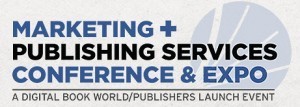 McCarthy in his good piece for DBW is writing as one of the main programming people for the highly promising new conference event, Marketing + Publishing Services Conference & Expo (hashtag: #DBWMP) It’s set for September 26 in New York City and you may have seen me tweeting about it.
McCarthy in his good piece for DBW is writing as one of the main programming people for the highly promising new conference event, Marketing + Publishing Services Conference & Expo (hashtag: #DBWMP) It’s set for September 26 in New York City and you may have seen me tweeting about it.
 A follow-up to F+W Media’s excellent Discoverability Conference of last fall—about which I wrote here at DBW and here on the Ether—this new 2013 conference is a co-production of DBW and of the Publishers Launch series produced by Mike Shatzkin and Michael Cader.
A follow-up to F+W Media’s excellent Discoverability Conference of last fall—about which I wrote here at DBW and here on the Ether—this new 2013 conference is a co-production of DBW and of the Publishers Launch series produced by Mike Shatzkin and Michael Cader.
I’m glad to be working with F+W on its conferences and I can offer readers of the Ether a 25-percent saving on registration for the Marketing + Publishing Services Confab with the use of the discount code PORTER at registration. I’m looking forward to covering this one; its roster of speakers has been growing more impressive all summer.
Now, Shatzkin recently wrote a helpful article on McCarthy’s work. In 7 starter principles for digital book marketing learned from Peter McCarthy, Shatzkin observes:
Pete’s really invented something in publishing by looking for comparable products that aren’t other books, but outside publishing they know all about seeking comps that aren’t precisely the same as their own product. The techniques Pete employs to find audiences in people that are like the known audiences for a book are standard tools in consumer marketing outside publishing.
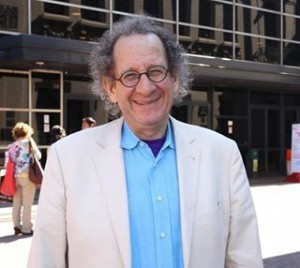
Mike Shatzkin
As Shatzkin goes on to enumerate some of those starter principles McCarthy uses, you can readily spot things entrepreneurial authors know well. For example:
The digital marketing menu contains nearly an infinite number of items. That results in a tremendous amount of wasted effort spent trying things that a little research would have indicated will never work.
McCarthy confirmed to me in a tweet exchange a few days ago, that the realistic approach is something like an “agile” effort in publishing. You iterate and re-iterate marketing components, changing tack according to what’s working. And yes, there can be some waste in there as various things are tried and put aside if not producing, especially if research doesn’t precede the trial (and the error): budgeting for marketing, as Shatzkin discusses, may not mean what it once did.
Well, this isn’t that far from what authors experience in adjusting their online book pricing, is it? You see them:
Bobbing and weaving as price points seem to work well, then fade among the algorithms almighty;
Trying their best to learn which guest blog posts might really benefit them (“is that blog’s readership a near-comp for my target crowd?”);
Reading entrails to guess when a giveaway is right and when it will produce no returns, just greedy takeaway-ers.
This morning, my job could be described as “Ginger Clark and the case of the confusing check from a corporation known for disorganization.”
— Ginger Clark (@Ginger_Clark) August 15, 2013
And how about the point we make so frequently with writers that there’s no such thing as being out-of-print in the digital era? Shatzkin on McCarthy’s point No. 6;
The whole concept of “time” also needs to be rethought…not just how long programs run but also when they take place in relation to the lifecycle of the book. In the digital era, whether books are well-represented in stores at any moment is not necessarily the key determinant of how well they’ll sell, so pushing a backlist book that might be thinly distributed but which is suddenly timely is perfectly sensible…And it wasn’t that way five or ten years ago when marketing efforts wouldn’t be extended if books weren’t in the stores.
These are good points, Shatzkin’s piece makes them well, and McCarthy’s guidance rings true. And? And this is heartening in another way. While much of the conference-event structure for entrepreneurial authors and corporate-publishing people remains separate, look how the topics of salesmanship are converging.
The Discovery Myth (with tweets): http://t.co/aSYYqd0vId cc: @Porter_Anderson @peterturner @arhomberg
— Guy L. Gonzalez (@glecharles) August 15, 2013
No regular readers of the Ether are having any trouble following the issues we’re flagging here. McCarthy and Shatzkin are working on an event created primarily for publishing-industry folks, but their talking points are things entrepreneurial authors are tracking right along with them, and very close to the ground, too, no layers of corporate departments underneath.
Shatzkin:
Understanding the book and author’s digital connections and the right language to describe the book you’re selling are “foundational” elements; everything flows from them.
For authors?
 After Marketing + Publishing Services, I’ll be in Los Angeles for F+W Media’s next event: Writer’s Digest West (hashtag: #WDCW13)—for authors, not the corporati—opens on September 27 with a full day’s conference-within-a-conference on self-publishing. I’m moderating a panel there—“Congratulations! You Published It — Now, How Do You Sell It?”—with Amazon’s Jon Fine; Bookigee’s and WriterCube’s Kristen McLean; and author-filmmaker Eric DelaBarre. I’m also teaching my own Boot Camp again on Public Speaking for Writers, and covering the full conference. On that one, too, you can save 25 percent with code PORTER, and I’d be so glad to see you there.
After Marketing + Publishing Services, I’ll be in Los Angeles for F+W Media’s next event: Writer’s Digest West (hashtag: #WDCW13)—for authors, not the corporati—opens on September 27 with a full day’s conference-within-a-conference on self-publishing. I’m moderating a panel there—“Congratulations! You Published It — Now, How Do You Sell It?”—with Amazon’s Jon Fine; Bookigee’s and WriterCube’s Kristen McLean; and author-filmmaker Eric DelaBarre. I’m also teaching my own Boot Camp again on Public Speaking for Writers, and covering the full conference. On that one, too, you can save 25 percent with code PORTER, and I’d be so glad to see you there.
 There’s even a simultaneous event in LA, Screenwriters World (hashtag: #SWCW13), specifically for the film folks. (And even there, the discount code will work; go for it.)
There’s even a simultaneous event in LA, Screenwriters World (hashtag: #SWCW13), specifically for the film folks. (And even there, the discount code will work; go for it.)
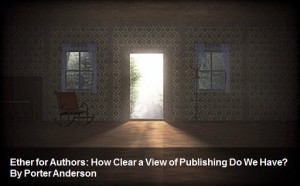 In Tuesday’s Ether for Authors: How Clear a View of Publishing Do We Have? at Publishing Perspectives, I wrote about how great it would be to see an authors’ edition of the Bowker Market Research team’s terrific 2013 U.S. Book Consumer Demographics & Buying Behaviors Annual Review.
In Tuesday’s Ether for Authors: How Clear a View of Publishing Do We Have? at Publishing Perspectives, I wrote about how great it would be to see an authors’ edition of the Bowker Market Research team’s terrific 2013 U.S. Book Consumer Demographics & Buying Behaviors Annual Review.
I’ll offer you one canny viewpoint from that survey of interest to many entrepreneurial authors. You know how we love to say, “Oh, that genre is really taking off now,” or “this genre is hot, hot, hot, it’s the new sci-fi,” etc.? But a lot of that appears to be in our anec-data-loving heads. A Hunger Games or Game of Thrones or Fifty Games in the Shade rolls over us and we think one genre or another now is leaping past the others, right? Maybe not so right.
Between 2009 and 2012 there have been only small shifts among both the major categories and subgenres. Over the four year period, the three percentage point change in spending by the adult fiction category, for example, was the biggest shift among major categories.
Romance? “Romance, Porter?” you ask, ready to hear tales of genre-vaulting Shirtless Men Kissing Beautiful Women.
In 2009, 2010, 2011, and 2012, uh, no. Bowker’s data tells us that romance held steady in market share. In units sold, 6 percent, all four years. In dollars sold, 3 percent, all four years. Seems to me that a lot of perfectly good shirts died for not a lot of progress, but my silly bias isn’t the point: what’s interesting here is that we can perceive big strides in areas of the industry that may not be borne out by the numbers.
 No disrespect here for those numbers, however: By comparison, fantasy sat still at 2 percent in dollars, all four years; its biggest “bump” was moving from 2 percent to 3 percent of units sold in 2011 and 2012.
No disrespect here for those numbers, however: By comparison, fantasy sat still at 2 percent in dollars, all four years; its biggest “bump” was moving from 2 percent to 3 percent of units sold in 2011 and 2012.
And to push on to our conclusion today, I’ve got another wish.
In addition to an author-focused and -priced version of Bowker’s enlightening work, I’d love to see marketing folks produce their best stuff with two “adjacent audiences” in mind: corporate publishing, sure, but also entrepreneurial authors. We probably could use full-day or half-day marketing conference events for entrepreneurial authors, not just for our corporate colleagues.
I want you to read the next passage without looking below to see who wrote it. I think you’ll find it makes the point well that folks from both major “sides” of the industry are beginning to talk like “adjacent fans” of each other, when it comes to marketing books.
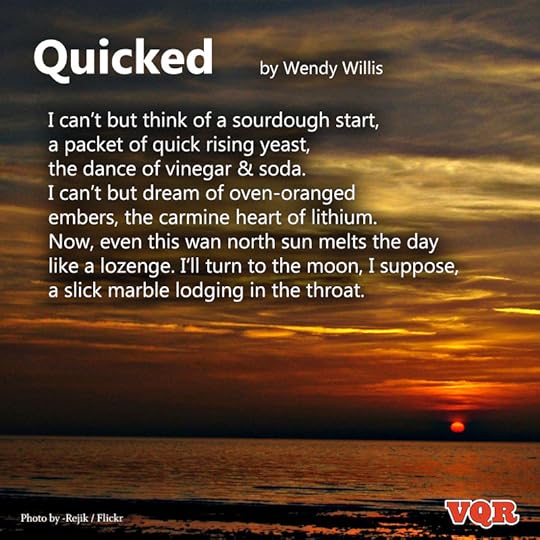
From VQR: More on poet Wendy Willis
Wait. Who Wrote That?
OK, now don’t look below, no cheating. Just read this first:
As the number of books grows that have commercial appeal but which are published so far outside the conventional trade that their sales aren’t even captured in industry data, it further weakens the legacy publishing ecosystem and further encourages both established and aspiring authors to work around it.
Aspiring authors every week see books on the NY Times Bestseller List that are either self-published or have imprint names they’ve never heard of.
When conventional publishing requires an agent to get a deal (which it does, and which takes time), then you have to wait for publishers to make a buy-or-not decision (more time), and then put your book out on a trade publishing schedule that usually wants to give Barnes & Noble and other retailers months of advance notice (still more time), it can seem ever-so-much-more appealing to just skip the wait and go straight to self-publishing, which will put books on sale right now (more or less).
I’ll even toss in one more short bit, to see if I can throw you off on who’s writing:
The single biggest reason (aside from a fat advance payment, which few get) for authors to work through a publisher is to get the distribution of printed copies to many stores.
 Barry Eisler! You’re sure of it, right?
Barry Eisler! You’re sure of it, right?
I would be, too.
Remember when he said that the main advantage to authors of legacy publishers was their distribution capability? It was in his keynote address at the Pikes Peak conference and his comments were attacked by literary agents on the spot? I wrote about it here, in Ether for Authors: The Establishment Strikes Back and in Writing on the Ether: Agents and Authors at the Coalface.
But guess what. This isn’t Eisler.
No, it’s our good friend Shatzkin again. Those quotes I just gave you are from a brand-new esssay, more recent than his article on McCarthy.
 In Losing bookstores is a much bigger problem for publishers than it is for readers, Shatzkin is working this time toward Publishers Launch Frankfurt on October 8—which runs parallel to the Frankfurt Academy’s CONTEC Conference (hashtag #CONTEC) in which I’ll be moderating. (More on that one soon.)
In Losing bookstores is a much bigger problem for publishers than it is for readers, Shatzkin is working this time toward Publishers Launch Frankfurt on October 8—which runs parallel to the Frankfurt Academy’s CONTEC Conference (hashtag #CONTEC) in which I’ll be moderating. (More on that one soon.)
 Too many times I’ve heard people say that Shatzkin, a longtime consultant to elements of the traditional-publishing establishment, was “old guard” and “old school.” What I get in his writings, like those of McCarthy, is increasingly applicable to the challenges facing entrepreneurial authors, not just to publishing companies. What I like seeing Shatzkin do is play these challenges back to the client base in Manhattan in ways that make the world’s workforce of ever-more-sophisticated authors take on new clarity and position.
Too many times I’ve heard people say that Shatzkin, a longtime consultant to elements of the traditional-publishing establishment, was “old guard” and “old school.” What I get in his writings, like those of McCarthy, is increasingly applicable to the challenges facing entrepreneurial authors, not just to publishing companies. What I like seeing Shatzkin do is play these challenges back to the client base in Manhattan in ways that make the world’s workforce of ever-more-sophisticated authors take on new clarity and position.
As bookstores become less powerful discovery engines (fewer of them farther apart and fewer books on display in those that are left), people are forced to find out about books some other way. Many of those other ways are already online (without even counting the suggestions of online retailers). A lot of “word-of-mouth” these days is digital communication (email, Facebook, Twitter, or even a blog).
And as those traditional publishers find their own fortunes challenged by the same hurdles facing entrepreneurial authors, the science of identifying and wooing McCarthy’s “adjacent fans” will become more critical to both.
When an author is tired of checking his/her Amazon rating, he/she is tired of life.
— Jonny Geller (@JonnyGeller) August 13, 2013
Of all things, the difficulties of reaching readers in a content-choked market may be the most unifying element the industry has seen in a decade of digital disruption.
The entrepreneurial author, maybe in business for five years so far, needs his book “discovered” by a reader, right? Well, shake hands with the decades-old publishing house with two logos smacked on its merged forehead: same challenge.
Which is why we read Shatzkin writing this to publishers:
If you do straight narrative reading, your books may continue to sell in equivalent or even better numbers [as ebooks] than they did previously, but both your authors and your retailers will be looking hard at what you take and wondering if they can go around you. Your challenge will be to continue adding enough value to be worth enough of a share to have a business.
What do you think? Can you see more ways in which entrepreneurial authors’ marketing challenges are closer to those of traditional publishing than might have been expected? And how about “adjacent fans?” Any experience in marketing books to them?
Umbrella texting. Why sell this as an umbrella and not just a grip you add to any umbrella? http://t.co/pZNm1jvbX5
— Craig Mod (@craigmod) August 14, 2013
Main image: iStockphoto – DWPhotos
The post WRITING ON THE ETHER: Are You Marketing to Your “Adjacent Fans”? appeared first on Jane Friedman and was written by Porter Anderson.
August 12, 2013
The Collapse of a Writing Routine—and How It Was Restored

The workspace of Frances Kazan
T oday’s guest post is by Frances Kazan, the widow of famed director Elia Kazan.
For years I was a disciplined writer. After walking the dog, I was seated at my desk by 9 a.m. After 500 words I’d go downstairs for lunch, followed closely by the dog. Sometimes my husband joined us, and sometimes he didn’t. Like me, he was a writer; his office was on the floor above mine. Around 2 p.m. I would return to edit, then I took off for either a yoga class or a walk in the park. Following this routine, I finished a master’s thesis (later published), a historical novel, Halide’s Gift, numerous articles for Cornucopia magazine, several lectures, and the first draft of another novel, The Dervish.
I used to work in the writers room at the local library. When that became too crowded, I put a desk in the corner of our bedroom, not a satisfactory arrangement. For a while I returned to the library of the university where I earned my degree, as an older (wiser) student, but the commute consumed precious time. Then my son graduated, his bedroom became my office, its windows overlooking the gardens at the back of the house. I used to gaze out at the plane trees and ivy-covered walls through a line of Grateful Dead stickers.
I was blessed. I had my own private space, where the silence was broken only by the thud of my husband’s typewriter, and the dog snoring on the sofa. I loved being alone with my thoughts and my work, absorbed by the flow of writing, oblivious to the passage of time.
Time and change are unavoidable; gradually my husband’s health declined. The two of us continued to work during that last hot summer, then, three weeks after his birthday, he died. In defiance of this truth I kept writing, clinging to my routine to maintain the appearance of normality, but the silence overhead became a crashing noise.
Dealing with the practicalities was overwhelming. First the execution of the will, then going though his papers stored in a room full of filing cabinets. Our house, too big for one person, had to be sold. The task of making it “market ready” consumed me. Eventually I moved out of our home of 20 years, taking the dog and my husband’s cat, forcibly pried from his study.
My writing routine collapsed. The manuscript of The Dervish languished in a drawer. Then 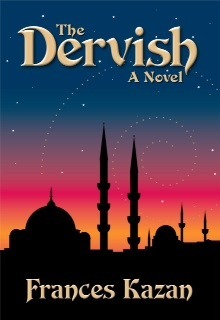 disaster: my dog was diagnosed with incurable blood cancer.
disaster: my dog was diagnosed with incurable blood cancer.
For several years I did not write another word. I traveled, found a new home, created a new life. One day generous friends loaned me their yali in Istanbul, where, in a room facing the Bosphorus, I returned to my manuscript. It wasn’t easy at first, thoughts were hard to organize, the right word was elusive. Eventually my routine was restored.
So here I sit at a new desk, in a new apartment, in another neighborhood, writing a blog to publicize the e-book edition. The Dervish has been published, a real book I can hold in my hand. Close by, my husband’s cat is asleep on the sofa, she’s frail, her gait is unsteady. I’ve lost track of her age.
The post The Collapse of a Writing Routine—and How It Was Restored appeared first on Jane Friedman and was written by Frances Kazan.
The Collapse of a Writing Routine—and How It Was Restored by Frances Kazan

The workspace of Frances Kazan
T oday’s guest post is by Frances Kazan, the widow of famed director Elia Kazan.
For years I was a disciplined writer. After walking the dog, I was seated at my desk by 9 a.m. After 500 words I’d go downstairs for lunch, followed closely by the dog. Sometimes my husband joined us, and sometimes he didn’t. Like me, he was a writer; his office was on the floor above mine. Around 2 p.m. I would return to edit, then I took off for either a yoga class or a walk in the park. Following this routine, I finished a master’s thesis (later published), a historical novel, Halide’s Gift, numerous articles for Cornucopia magazine, several lectures, and the first draft of another novel, The Dervish.
I used to work in the writers room at the local library. When that became too crowded, I put a desk in the corner of our bedroom, not a satisfactory arrangement. For a while I returned to the library of the university where I earned my degree, as an older (wiser) student, but the commute consumed precious time. Then my son graduated, his bedroom became my office, its windows overlooking the gardens at the back of the house. I used to gaze out at the plane trees and ivy-covered walls through a line of Grateful Dead stickers.
I was blessed. I had my own private space, where the silence was broken only by the thud of my husband’s typewriter, and the dog snoring on the sofa. I loved being alone with my thoughts and my work, absorbed by the flow of writing, oblivious to the passage of time.
Time and change are unavoidable; gradually my husband’s health declined. The two of us continued to work during that last hot summer, then, three weeks after his birthday, he died. In defiance of this truth I kept writing, clinging to my routine to maintain the appearance of normality, but the silence overhead became a crashing noise.
Dealing with the practicalities was overwhelming. First the execution of the will, then going though his papers stored in a room full of filing cabinets. Our house, too big for one person, had to be sold. The task of making it “market ready” consumed me. Eventually I moved out of our home of 20 years, taking the dog and my husband’s cat, forcibly pried from his study.
My writing routine collapsed. The manuscript of The Dervish languished in a drawer. Then  disaster: my dog was diagnosed with incurable blood cancer.
disaster: my dog was diagnosed with incurable blood cancer.
For several years I did not write another word. I traveled, found a new home, created a new life. One day generous friends loaned me their yali in Istanbul, where, in a room facing the Bosphorus, I returned to my manuscript. It wasn’t easy at first, thoughts were hard to organize, the right word was elusive. Eventually my routine was restored.
So here I sit at a new desk, in a new apartment, in another neighborhood, writing a blog to publicize the e-book edition. The Dervish has been published, a real book I can hold in my hand. Close by, my husband’s cat is asleep on the sofa, she’s frail, her gait is unsteady. I’ve lost track of her age.
The post The Collapse of a Writing Routine—and How It Was Restored appeared first on Jane Friedman and was written by Frances Kazan.
Jane Friedman
- Jane Friedman's profile
- 1882 followers


